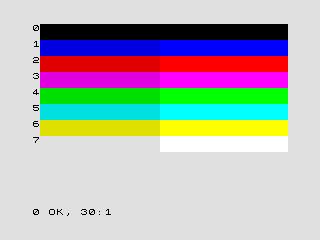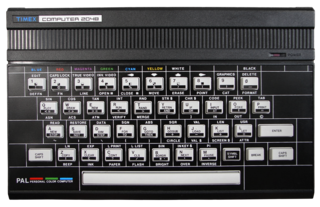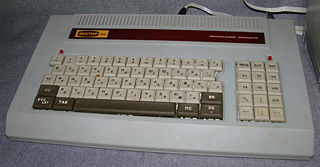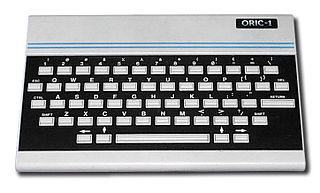Related Research Articles

The Amstrad CPC is a series of 8-bit home computers produced by Amstrad between 1984 and 1990. It was designed to compete in the mid-1980s home computer market dominated by the Commodore 64 and the ZX Spectrum, where it successfully established itself primarily in the United Kingdom, France, Spain, and the German-speaking parts of Europe.

The Jupiter Ace by Jupiter Cantab was a British home computer of the early 1980s. The Ace differed from other microcomputers of the time in that its programming environment used Forth instead of the more popular BASIC.

The ZX Spectrum is an 8-bit home computer that was developed by Sinclair Research. It was released in the United Kingdom on 23 April 1982, and became Britain's best-selling microcomputer.

The SAM Coupé is an 8-bit British home computer manufactured by Miles Gordon Technology (MGT), based in Swansea in the United Kingdom and released in December 1989.
Sinclair BASIC is a dialect of the programming language BASIC used in the 8-bit home computers from Sinclair Research and Timex Sinclair. The Sinclair BASIC interpreter was made by Nine Tiles Networks Ltd.

The Timex Sinclair 2068, released in November 1983, was Timex Sinclair's third and last home computer for the United States market. It was also marketed in Canada, Argentina, Portugal and Poland, as Timex Computer 2068.
Loki was the code name for a cancelled home computer developed at Sinclair Research during the mid-1980s. The name came from the Norse god Loki, god of mischief and thieves. Loki was based on the ZX Spectrum, but intended to rival the Amiga for video games.

The VTech Laser 200 is an 8-bit home computer from 1983, also sold as the Salora Fellow, the Seltron 200 in Hungary and Italy, the Smart-Alec Jr. by Dynasty Computer Corporation in Dallas, Texas for the USA, the Texet TX8000A, and the Dick Smith VZ 200 and the VTech VZ 200.

The Tatung Einstein was an eight-bit home/personal computer produced by Taiwanese corporation Tatung, designed in Bradford, England at Tatung's research laboratories and assembled in Bridgnorth and Telford, England. It was aimed primarily at small businesses.
Sinclair Research Ltd is a British consumer electronics company founded by Clive Sinclair in Cambridge. It was originally incorporated in 1973 as Westminster Mail Order Ltd, renamed Sinclair Instrument Ltd, then Science of Cambridge Ltd, then Sinclair Computers Ltd, and finally Sinclair Research Ltd. It remained dormant until 1976, when it was activated with the intention of continuing Sinclair's commercial work from his earlier company Sinclair Radionics, and adopted the name Sinclair Research in 1981.
Timex Sinclair was a joint venture established in December 1982 between the British company Sinclair Research and Timex Corporation in an effort to gain an entry into the rapidly growing early-1980s home computer market in North America.

The ATM Turbo, also known simply as ATM is a ZX Spectrum clone, developed in Moscow in 1991, by two firms, MicroArt and ATM.

The original ZX Spectrum computer outputs video through an RF modulator and was designed for use with contemporary 1980s television sets, for a simple colour graphic display.

The Timex Computer 2048 or TC 2048 is a 1984 computer developed by Timex Portugal, at the time part of Timex Sinclair. It was based on the Timex Sinclair 2048 prototype, with a similar redesign case, composite video output, Kempston joystick interface, and additional video modes, while being highly compatible with the Sinclair ZX Spectrum computer.

The Timex FDD 3000 in 1982 was a nearly complete computer by Timex of Portugal. It began its development at Timex Computer Corporation in the U.S., but it was at Timex of Portugal that the work was finished.

Vector-06C is a home computer with unique graphics capabilities that was designed and mass-produced in USSR in the late 1980s.

The Unipolbrit Komputer 2086 was a Polish version of the home computer Timex Sinclair 2068, produced by a joint venture of the Polish state-owned Unimor and foreign company Polbrit International. Introduced in 1986, the computer had a cost of roughly 190000 zł.

Oric was the name used by UK-based Tangerine Computer Systems for a series of 6502-based home computers sold in the 1980s, primarily in Europe.

The Scorpion ZS-256 was a very widespread ZX Spectrum clone produced in St. Petersburg by Sergey Zonov.
References
- ↑ "Visit guide". Museum LOAD ZX Spectrum. Retrieved 2022-12-13.
- ↑ "Timex FDD-3000". Silicium (in French). 2003. Retrieved 2022-12-13.
- 1 2 Prata, Fernando (May 13, 1987). "TC 3256: A proposta Timex no mundo das aplicações profissionais" [TC 3256: The Timex proposal in the world of professional applications](PDF). Micro Se7e (in Portuguese). No. 46. pp. 1–2.
- ↑ Red, Johnny (2001). "Timex Computer 3256". Timex Computer World (in Portuguese).
- 1 2 3 Adamski, Jarek (2009). "Timex Computer 3256". 8bit Projects For Everyone.
- ↑ Red, Johnny (2001). "Timex Computer 3256 Prototype". Timex Computer World.
- ↑ Owen, Andrew (July 7, 2022). "Updating a 40-year-old computer design". Andrew Owen | Writer | Designer. Retrieved 2022-12-13.
- 1 2 "Timex Computer 3256, Timex Portugal". Kio's Sinclair ZX Computers Archive.
- 1 2 Florindo, Bruno. "CIRCE - AMERICAN COUSINS" (PDF). Byte High No Limit (22): 64.
- ↑ "SCLD Chip". Timex/Sinclair - The Authoritative Website for Timex/Sinclair Computers. Retrieved 2023-01-27.
- ↑ "Scld in spectrusty::chip::scld - Rust". docs.rs. Retrieved 2023-01-27.
